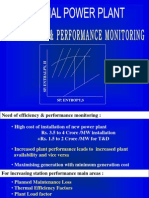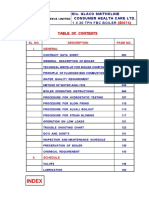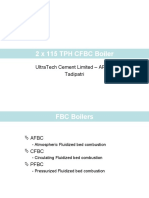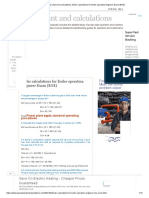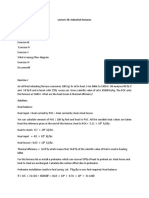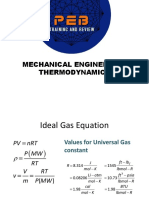Boiler Reference
Boiler Reference
Uploaded by
tagolimotCopyright:
Available Formats
Boiler Reference
Boiler Reference
Uploaded by
tagolimotCopyright
Available Formats
Share this document
Did you find this document useful?
Is this content inappropriate?
Copyright:
Available Formats
Boiler Reference
Boiler Reference
Uploaded by
tagolimotCopyright:
Available Formats
II. B. Design Computation Relevant to Boiler A Capacity II.B.
1 Combustion Analysis: Expected boiler performance: MCR 220,000 lb/hr
Operating Steam Pressure - 250 psig with 92F SH Superheat Temperature Feedwater Temperature - 506F - 221
Ultimate Analysis of bagasse in % by weight Australia practice, Component Carbon, C Hydrogen, H2 Oxygen, O2 Moisture Ash Total % Weight 23.50 3.25 21.75 50.00 1.50 100.00
The combustible element in the bagasse are Carbon & Hydrogen, burning it gives off By weight: C 12 1 + + O2 32 = = CO2 44 3.67 and 2H2 4 1 + + + O2 = 2H2O 32 = 8 = 36 9
+ 2.67 =
Consider combustion of one (1) pound bagasse without excess air: 0.235 lb C requires 0.6274 lb O2 to produce 0.8624 lb CO2 0.0325lb H2 requires 0.26 lb O2 to produce 0.2925 lb H2O
However, the bagasse already contain 0.2175 lb O2. Hence, the air must supply theoretical O2 of: 0.6274 lb + .26 lb 0.2175 lb = 0.6699 lb O2
Assumed: O2 (Oxygen) is 23% by weight of air N2 (Nitrogen) is 76% by weight of air Other Gases is 1% by weight of air (Source: Encarta Premium 2007) Therefore Theoretical air required Nitrogen in air, N2 : 0.6699/0.23 : 2.9126(0.77) = = 2.9126 lbs 2.2453 lbs
Allow 40% excess air to insure complete combustion. Flue gas components for one (1) pound bagasse fuel CO2 H2O 0.8624 lb Product of combustion 0.7925 lb Product of combustion & moisture in bagasse
O2 (0.6699 X 0.40) 0.2679 lb Excess Oxygen N2 (2.2453 X 1.40) 3.1434 lb Combustion of air Total = 5.0662 lb Flue gas/lb bagasse
Calorific Value of Wet Bagasse: with w moisture % bagasse 50, s sucrose % bagasse 2.5 Gross Calorific Value, GCV = 8,280(1-w) 2,160s GCV = 8,280(1-0.50)- 2,160(0.025) = 4,140 - 54
GCV = 4,086 Btu/lb
Net Calorific Value,
NCV = 7,650-8730(w)- 2,160(s) = 7,650-8730(0.5)-2,160(0.025) NCV = 3,231 Btu/lb
The projected flue gas temperature after economizer is 330F. The mean specific heat at average flue gas
temperature T, T = (330F - 32F)/2 = 149F
N2: O2:
0.246 + 0.000011T 0.214 + 0.000010T
= = = =
0.2476 0.2155 0.4809 0.2058
H2O: 0.468 + 0.000087T CO2: 0.199 + 0.000046T
Heat losses in one (1) pound of bagasse fuel: a) Latent heat of H2O from combustion of H2 in the bagasse. b) Latent heat of H2O contained in bagasse. Note: Heat losses in items a) and b) are already
accounted in the NCV formula. c) Sensible heat loss of the flue gas leaving the air heater , qa Assume flue gas temperature before air pre-heater 680F (360C), and after air pre-heater 520F (271C). N2 O2 : 0.2476(680-520)(3.1434) = 124.1 Btu/lb : 0.2155(680-520)(0.2679) = 9.2 Btu/lb
H2O CO2
: 0.4809(680-520)(0.7925) = : 0.2058(680-520)(0.8624) =
60.9 Btu/lb 28.4 Btu/lb = 222.6 Btu/lb
Total sensible heat loss, qa d) Losses in unburned solids Factor = = e)
coefficient to account unburned solids 0.975 for spreader stoker
Losses by radiation from furnace and esp. from boiler Factor = coefficient to account radiation & convection = 0.97 for normal rating
f)
Losses due to incomplete combustion Factor = 0.96 average value and will be better with lower moisture, lower excess air, and higher furnace temp. The modern furnace easily exceed 0.90 and for well conducted combustion, use 0.96 average.
g)
Losses due to flue gas exiting the ID fan to the chimney, qc qc = [(1-w)(1.4 m 0.13) + 0.5](t-32) where: w = bagasse moisture,0.50 m = ratio of air supplied to theoretically needed, 1.4 t = flue gas temp. at ID fan exit, 330F qc = 407.5 Btu/lb
Net heat transferred to steam, M M = (NCV qc)
(3,231 407.5) X (0.975)(0.97)(0.96)
2,563.5 Btu/lb
Over-all boiler thermal efficiency, = = = M / GCV X 100% 2,563.5 / 4,086 X 100% 62.7 %
II.B.2. Bagasse Consumption Calculation: Steam outlet condition, h1 h1 = 1,265.08 Btu/lb 265 psia & 506F
Feed water inlet condition, hf hf = 189.23 Btu/lb 221F
Heat absorbed by steam, Ms Ms = = = Ws (h1 - hf) Btu/hr
220,000(1,265.08-189.23) 236,687,000 Btu/hr
Boiler heat input, Mi Heat absorbed by the steam Over-all boiler thermal eff. = = = Ms / q 236,687,000 Btu/hr / 0.6273 377,310,696.6 Btu/hr Btu/hr
Mi
Bagasse consumption, Wb Wb = Boiler heat input / GCV of bagasse 5
= Wb =
377,310,696/ 4,086 92,342.3 lbs/hr
II.B.3. Flue Gas Condition At Air heater Outlet At 520 air pre-heater outlet temperature and
approximately atmospheric pressure, 1. A mol is weight of the substance , lb/molecular
weight of the substance 2. A mol volume is 380 cu. Ft. at 60F and 14.7 psia.
This is independent of the kind gas. 3. At T R and p psia, the mole volume is Mol volume = 10.72 T / p T = = p Mol volume = = = Where: 520 + 460 absolute temp. 980R 14.7 psia
10.72 (980) / 14.7 715 cu.ft/mol
Molar weight of flue gas per pound bagasse: CO2 H2O C02 N2 = = = = 0.8624 / 44 0.7925 / 18 0.2679 / 32 3.1434 / 28 Total = = = = = 0.0196 0.0440 0.0083 0.1123 0.1842 Mol/lb bagasse
Volume of flue gas per lb bagasse, Vf Vf = = = (Mol volume)(Molar weight flue gas/lb bag. (715 cu.ft/mol)(0.1842 Mol/lb bagasse) 131.7 cu.ft/lb bagasse
Volume of flue gas, V
Volume of flue gas per lb bagasse X Bagasse consumption lbs/hour
= = =
131.7 X 92,342.3 12,161,482.8 cu.ft/hr 202,691 cu.ft/min
Weight of flue gas, Wf Wf = Bagasse consumption X Weight of flue gas per lb bagasse, lb/hr = Wf = = 92,342.3 X 5.0662 467,824.6 lbs/hr 212,647.5 kgs/hr
II.B.5. Evaporation Rate of the Boiler: All water tube boilers are capable of normal rate of 4.4 lb/ft2/hr. Boiler with vertical bent tubes,
economizer, air heater and spreader stoker furnace a rate of 8.7 can be achieved. If the economizer and air heater
is of generous dimension, a rate of 10 is possible.
Evaporation rate, = = = Steam generated / boiler heating surface 220,000 lb/hr / 28,913 ft2 7.61 lb steam/ft2/hr
Note: This figure is within the 7-8 lb/ft2/hr typical of spreader stoker furnace.
II.B.6. Furnace Design: a) Combustion Rate:
Heat releases in the furnace is advisable to be about 25,000 Btu/cu.ft./hr and should not go above 40,000
reckoned on GCV.
Furnace area heat release should be
within 600,000 to 900,000 Btu/ft2/hr of grate area. Boiler A furnace dimensions: Grate area = = Furnace volume = = = 15.916 ft X 30.687 ft 488.41 ft2 Grate Area X furnace height, cu.ft. 488.41 X 31.5 15,384.9 cu.ft
Total heat of bagasse based on GCV, Hb Hb = = = GCV X Bagasse consumption, Btu/hr 4,086 Btu/lb X 92,342.3 lb/hr 377,310,637 Btu/hr
Furnace volume Heat release, FVHR FVHR = Total heat of bagasse based on GCV / Furnace volume, = = Btu/cu.ft/hr
377,310,637 / 15,384.9 24,524.7 Btu/cu.ft/hr (This figure is within the value acceptable for combustion rates)
Furnace area heat release, FAHR FAHR = Total heat of bagasse based on GCV / Grate Area, = = Btu/ft2/hr
377,310,637 / 488.41 772,528 Btu/ft2/hr
(This figure is also within range)
Weight of bagasse burnt per unit grate area, For spreader stoker furnaces operating at continuous ratings, combustion rate per unit grate area for high rate is between 160-200 lb/ft2/hr, preferably should not exceed 175. formula, = Weight of bagasse burnt per hour / area of the grate = 92,342.3/ 488.41 = 189 lb/ft2/hr (slightly above the recommended value, Of 175, but still ok since suspension firing is employed) Ratio of boiler heating surface to grate area, This ration is of the order 50-70. stoker it is in the neighborhood of 50. = heating surface of the boiler / area of the grate = = 28,913 / 488.41 59 (slightly above the recommended) For spreader For Boiler A as given by the following
II.B.7. Design of superheater a) Steam velocity at superheater tubes: Verify existing loop: Data: 55 heating elements, 2 diameter 0.157 thick 250 psig outlet steam pressure, 506F temp. 9
220,000 lb steam/hr (upgraded capacity) Specific volume of steam, 2.0362 cu.ft./lb
Volumetric flow of steam, Vfs Vfs = = 220,000 X 2.0362 / 3600 124.43 cu.ft/sec
Flow area of 55 tubes with 1.4351 inside diameter, Af Af = = X 1.4351 X 1.4351 X 55/4 (1/144) 0.6177 ft2
Velocity of steam passing the 55 tubes, Vs Vs = = = Vfs / Af ft/sec
124.43 / 0.6177 201.44 ft/sec (within acceptable range of 130-210 ft/sec for super heated steam per European practice)
II.B.8. Temperature of steam at given heating surface For 55 tubes 2 diameter with effective heating length of 30 ft, the heating surface area is 728 ft2. From Handbook by Hugot p.883, furnace temperature
obtained in practice for a bagasse fired boiler is: Most inefficient furnace Highest recorded Continuously Most Common Super heater gas inlet For Boiler A and calculation 1,700F 1500-1800F 2,350F 2.275F 2,000F 1,500-1800F 2,000F furnace gas
assume
temperature temperature.
superheater
inlet
10
a) Ts
Superheater outlet steam temperature, Ts K S(2T1-t)/2 + p[ct-r(1-x)][1+S K/(2 P C)] = (K S/2) + p c [ 1 + K S /(2 P C) ]
Where:
Ts S
= =
temperature of superheated steam, F heating surface area of superheater, 728 ft2, or 67.66 m2
coefficient of heat transfer, assume 11 Btu/ft2 hr F or 60 kcal/m2 C hr
temperature of saturated steam at drum pressure of 280 psia, 411F or 210.5C
mean specific heat of superheated steam, 0.468 + 0.000087 (411F)
= r =
0.503 kcal/kg C latent heat of vaporization at the boiler drum pressure of 280 psia, 454 kcal /kg
= =
mean specific heat of flue gas 0.27 + 0.00003 Tm Where Tm = (1,700F-32F)/2 = 834F
C p
= =
0.303 kcal/kg C weight of steam to be superheated, 220,000 lb/hr or 100,000 kg/hr
weight of flue gas passing the superheater, 467,824.6 lb/hr or 212,647.5 kg/hr
T1
temperature of flue gas at entrance of 11
super heater, 1,700F or 926.6 C
T2
temperature of flue gas leaving the super heater = coefficient, equal or less than 1, generally 0.9 x = dryness fraction of the saturated steam (0.8-0.98 in general), use 0.93
Substituting all the given value to the formula, Ts = 265C or 509F (the projected steam temperature at the superheater outlet is 506F)
b)
Degree superheat, at the super heater outlet, SH SH = = = Ts t 265.3C 210.5C 54.8C or 98F
c)
Temperature of flue gas leaving the superheater, T2 T2 = T1 p [ (1-x)r + c(Ts - t) ] / P C (eq. 42.63 p.907 Handbook by Hugot) = 819.9C or 1507.8F
d)
Pressure drop at superheater, Pd Data: 55 elements, 2 OD 0.157 thick but inlet and
outlet spool connected to the superheater headers has OD of 1.75 with thickness 0.157 approximately 33 ft long, flow area per element 0.01123 ft2, 220,000 lb/hr MCR at
12
250 psig operating pressure and 506F super heat temperature, density of steam at operating condition 0.4911 cu.ft/lb.
Calculation: Vfs Af Ws = = = = = f = = 124.43 cu.ft/sec (previously computed) 0.6177 ft2 (previously computed)
steam flow per element 220,000 lb/hr / 4,000 lb/hr flow friction coefficient 0.0054 + 0.0375 z /( D V d ) (English units) (eq.14-15, for the flow of steam and air in pipes, p. 605 Power Plant by Morse) where : z = = viscosity of steam 0.0083 + (2 t / 100,000) 55 tubes
(eq. 14-16, viscosity of Steam, p. 606 Power Plant by Morse), t = 506F steam superheat temperature. = D = = V = 0.01842 centipoises tube inside diameter 1.4351 Velocity of steam passing the superheater tube, Vs = 201.4 ft/sec
13
= =
density of steam 0.4911 lb/cu.ft
Substituting all variables in the eq. for flow friction coefficient, f f = 0.005405
Friction loss in psi for the flow of steam or air, Pd Pd = f L d V / 6 g D (eq. 14.11 p.605 Power Plant by Morse) where: (see above data) f = 0.005405 L = tube length = 32.5 ft d = density of steam = 0.4911 lb/cu.ft V = flow velocity = 201.4 ft/sec g = 32.2 ft/sec D = tube ID = 1.4351 Substituting all the variables in the eq. for Pd, Pd = 12.62 psi
II.B.9. Design of air pre-heater This type of equipment recovers sensible heat from combustion gases before it passes to the economizer
assembly as in the case of Boiler A.
Combustion air
temperature of 482F can be attained but not considered
14
wise to exceed 356F, otherwise damage will be caused to the grate bars and refractory in the furnace due to
resulting high temperature. Verify heating surface area with the given air preheater air inlet and outlet temperature. Data: Total surface area of 2.5 OD, 0.126 thick,
2,054 pieces, 12 ft long Gas flow 467,824 lb/hr
16,150 ft2
Temperature of gas at outlet of air pre-heater, 520F
Temperature of gas at inlet of air pre-heater, 680F
Ambient temperature, 86F Tubes are arranged in a single bank 79 tubes wide x 26 tubes deep, in two passes
Weight of air at 40% excess, Wa Wa = = 2.9126 X 1.4 X 92,342 lb/hr 376,537 lb/hr
S = P C / k (r 1) ln (T - t ) / (To t) where S P p = = = = total heating surface required 467,824.6 lb/hr (flue gas) Wa, 376,537 lb/hr 0.92 0.95, say 0.935 for air heaters of metal with effective circulation. C = specific heat of the gas
15
= = c = = r = = k =
0.27 + 0.00003 T, T = 600F 0.288 Btu/lb F specific heat of air 0.24 Btu/lb F P C / p c 1.397 coefficient of heat transfer in the air heater, 3 4 Btu/ft2/h/F, say 3.7 Btu/ft2/hr/F
T t to To
= = = =
520F 356F 86F 680F
Substituting the values, S = = heating surface required, 25,135 ft2 ft2
But the actual heating surface is only 16,150 ft2. Examining the at variables, the air change in the it pre in is the air and flue gas
temperature change with
heater total
outlet heating for
that
would
the again
surfaces. heating
Substituting
equation
total
surface required, with S = 16,150 ft2, and finding t, heated air temperature after air pre-heater, t = 320F
II.B.10
Design of steam drum and water drum
Given: Steam drum inside diameter 5-0
16
Steam drum thickness Approximate straight length Water drum inside diameter Water drum thickness Approximate straight length a)
1-1/4
- 33-10-1/4 3-9 1
- 32-10-1/4
Ligament efficiency of longitudinal joints, E i) Screen, roof and down comer tubes E = (Pt dh) / Pt (100%) where: Pt = pitch of tube hole = 6-1/4 dh = diameter of hole = 3 E = = (6.25 3) / 6.25 (100%) 52%
ii) Main bank tubes E = (Pt dh) / Pt (100%) where: Pt = pitch of tube hole = 5-1/2 dh = 2-1/2 E = = (5.5 2.5) / 5.5 (100%) 54.54%
The minimum ligament efficiency is at longitudinal joint at screen, roof and down comer tubes, 52%.
17
b)
From PSME Code of 1993, p.119, Article 7.3, section for
7.3.1, the Maximum Allowable Working Pressure, MAWP steam drum MAWP = TS x t x E / R x FS where: TS = Ultimate tensile strength of shell plate @ 60,000 psi or 413.7 N/mm t = thickness of the drum = 1-1/4 or 31.75 mm E = minimum efficiency of drum longitudinal joint = 52% R = of the inside diameter of
the weakest course of the drum = 5 ft x 12 x 25.4 / 2 = 762 mm FS = Allowable safety factor = 5 Substituting all the variables in the equation, MAWP 413.7 N/mm x 31.75 mm x 0.52 MAWP = 762 mm x 5 = 1.79 Mpa or 260 psi
c)
Verification water drum design i) Efficiency of longitudinal joint, Ewd Ewd = = (Pt dh) / Pt (100%) 54.54% (computed previously)
ii) Maximum Allowable Working Pressure for water 18
drum, MAWP TS x t x Ewd MAWP = R x FS where: TS = 413.7 N/mm t = 25.4 mm R = 3-9 /2 = 22.5 or 571.5 mm FS = 5 MAWP = 2 Mpa or 290 psi
II.B.11. Verification of design of draught fans a) Induced draft fan Given: Flue gas volume MCR 169,000 cu.ft/min
Temperature at air pre-heater outlet - 520F Allow 20% margin on fan capacity-202,800 cu.ft/min Previous fan water gage design 9.36 Previous fan Hp MCR Previous RPM 370 920 640 920
Present fan Hp after upgrading Present RPM a.1) Gas pressure required: 19
(Total draft of a gas loop from p.477 Power Plant Engineering MKS Units by Morse) i) Furnace (D2) (5 mm) W.G. (30 mm) W.G. (80 mm) W.G. (80 mm) W.G. (80 mm) W.G. - (100 mm)
ii) Boiler exit (D3)
iii)Air pre-heater outletiv) Dust collector (D3) v) Economizer (D3) vi) W.G. vii) W.G. -
Scrubber exit (D3)
Breeching/chimney/ducts-
(5 mm)
Total draft required 380 mm Add 40% to fan pressure: 380 mm X 1.4 = 532 mm Note: item vii) draft represented by D4 was computed
separately for four different portions from outlet of air pre-heater to outlet of induced draft fan using the
formula given below: Air pre-heater outlet to connecting duct to economizer 0.0036 cm W.G. 0.09 cm W.G.
Connecting duct to economizer Economizer to induced draft fan Induced draft fan to chimney Total D4 or
0.0238 cm W.G. 0.34 cm W.G. 0.45 cm W.G. say 5 mm W.G.
D4
(d f V H) / 10 (2gR), cm
20
(eq. 12-3 p. 477 Power plant Engg by Morse MKS units) where: D4 = draft loss due to friction in in ducts, breechings, chimney d = flue gas density at IDF inlet temperature 300F, = f = 1.25 cu.m/kg 0.014 for flue against steel and concrete. H g = length of conduit, m = acceleration due to gravity, 9.7 m/sec R = hydraulic radius of cross Section, m (area/perimeter) V = velocity of flue gas at different cross sections
a.2) Fan power requirement, kWf kWif = Vf x Ps / 102 () where: Vf = flue gas volume flow, cu.m/sec = 202,800 cu.ft/min = 95.8 cu.m/sec Ps = static pressure required, mm W.G. = 532 mm W.G = drive efficiency, 85% kWif = = 95.8 x 532 / 102 (0.85) 587 kW
21
a.3) The actual fan design is double inlet double width backward curve blades centrifugal fan.
b)
Forced draft fan: Given: Weight of air, Wa @ 40% excess air - 405,007 lb/hr Density of air, a @ 30C (86F) - 0.0727 lb/cu.ft
i) Volume of air @ MCR
= = =
Wa
/ 60 ( ) / 60 (0.0727)
405,007
92,721 cu.ft/min
ii) Required capacity
= = =
92,721 cu.ft/min x 1.2 111,265 cu.ft/min 52.56 cu.m/sec
iii)Air pressure required: Furnace Air duct loss + (37 mm) + (25 mm) + (25 mm) + (37 mm)
Changes in directionAcross air heater -
Total air pressure required = 127mm Add 40% on air pressure required = 177.8
iv) Required power of the fan, kWfd kWfd = = = Vf x Ps / 102 (); = motor eff. 52.56 x 177.8 / 102 (0.85) 107 kw, say 150 Hp
22
v) The actual fan design is double inlet double width backward curve blades centrifugal fan 150 Hp 860 RPM
c)
Secondary air fan: This is the over-fire air fan that at least will
deliver about 20% of combustion air required inside the furnace. Given: Weight of combustion air Temperature of air Density of air at 86F 92,721 cu.ft/min 86F 0.0727 lb/cu.ft
c.1) Required capacity
= =
92,721 (0.15) (1.2) 16,689.8 cu.ft/min 7.88 cu.m/sec
c.2) Required draft, Ps i) Furnace + (400 mm) + (30 mm) + (30 mm) + (460 mm) + (575 mm)
ii) Air duct loss iii)Changes in direction Total required
Add 25% on req. draft c.3) Power requirement, kWsf kWsf =
Vf x Ps / 102 (0.85)
where: Vf = 7.88 cu.m/sec Ps = required draft, 723 mm = 0.85 ( drive eff.) kWsf = = 10.83 x 575 / 102 (0.85) 52.3 kW or 75 hp
23
II.B.12 Specification of feed water pump: Given: Steam generation (MCR) (This is upgraded capacity) Steam drum pressure Pressure loss due to economizer Pump suction line size Pump discharge line size 280 psia 15 psi 6 5 220,000 lb/hr
a) Volume required = total capacity required/density where: density = 1/specific volume @ 250F = 1/0.017001 = 58.82 lb/cu.ft MCR + 10% for emergency make 220,000 lb/hr 22,000 lb/hr 22,000 lb/hr 11,000 lb/hr 275,000 lb/hr
+ 10% for exceptional load 1 hr + 5% for blow downs Total capacity required -
Volume required = Volume required = = b) Head required: i) Suction Head
275,000 lb/hr / 58.82 lb/cu.ft 4,675 cu.ft/hr 2.208 cu.m/min
Velocity head = v / 2g where:
24
v = volume flow /area
6.6 ft/sec
Velocity head = (6.6)(6.6) / 2 (32.2) = 0.676 ft Static head = 25 ft loss due to 2 valves, 3 pc. 90 elbows, 50 ft of 6 pipes.
Friction loss=
- 2 valves fully open - 1m X 2 - 3 90 elbow - 60 ft of 6 pipe - 2m x 3 18m 28m
Total equivalent length= 2 f L v / g D
(eq. 14-10 p.605 Power Plant Engg by Morse MKS Units) where: f = coefficient of friction
0.424
= 0.0035+0.0007562(z/DVS) (eq 14-13 p.605 Power Plant Engg by Morse MKS Units) z = 0.1850 centipoise for water at 121C as extrapolated from Table 14-8 Viscosities p. 606 Power Plant by Morse) D = pipe ID, 6 or 0.152 m V = velocity at suction = 6.6 ft/sec, 2 m/sec
25
S = specific gravity @ 121C = 58.82/62.4 = 0.943 Substitute variables in equation for f, f = 0.00412 Then, substitute variables in equation for Friction loss, Friction loss = = 2 f L v / g D 0.625 m or 2 ft
Suction head = =
25 ft - 0.676 ft 2.05 ft 22.274 ft
ii) Discharge head o Velocity head= v / 2g where: v = volume flow/area 4,675 cu.ft/hr(4)144(1)hr = (5) ft2 (3600) sec = 9.5 ft/sec Then, velocity head = 1.4 ft
Pressure head= drum pressure x 2.31/sp. grav. where: drum pressure = 280 psi sp. grav. = 2 / 1 = 58.82/62.4 = 0.943 Pressure head= 280 x 2.31 / 0.943
26
685.89 ft
o o
Static head
35 ft (estimated) losses due to * 3 valves (full open)- 1m x 3 * 1 valve (3/4 open) 7m x 1 - 3m x 8 40m
Friction loss=
* 8 90 elbow * 130 ft of 5 pipe
Total equivalent length- 34m
= 2 f L v / g D (eq. 14-10 p.605 Power Plant Engg by Morse MKS Units) where: f = coefficient of friction
0.424
= 0.0035+0.0007562(z/DVS) (eq 14-13 p.605 Power Plant Engg by Morse MKS Units) z = 0.1850 centipoise for water at 121C as extrapolated from Table 14-8 Viscosities p. 606 Power Plant by Morse) D = pipe ID, 5 or 0.127 m V = velocity at suction = 9.5 ft/sec, 2.89 m/sec S = specific gravity @ 121C = 58.82/62.4 = 0.943 27
Substitute variables in equation for f, f = 0.004079 Then, substitute variables in equation for Friction loss, Friction loss = = 2 f L v / g D 1.88 m or 6 ft
Discharge head = Then, Head required
685.9 ft + 1.4 ft + 6 ft
= 693.3 ft = Discharge head Suction Head = 693.3 ft 22.274 ft = 671 ft or 204.5 m
c) Power requirement
Q dw H / 4,500,000 () where: Q = 2,208 l/min (liters/min) dw = 943 kg/cu.m H = 204.5 m = 0.90 (motor efficiency) 2,208 x 943 x 204.5
Power requirement
= 4,500,000 x 0.9 x 0.70 = 150 Hp, say 200 Hp
Hp
d) But the actual pump rating is: GPM (Boiler rating) GPM (Installed capacity) Rated head RPM Hp (Turbine driven) HP (Electric motor) 28 400 472 878 ft 3,600 190 250
Single stage Worthington, single suction with auto leak off non return valve at the discharge.
Therefore the existing pump is ok for the upgraded boiler.
29
You might also like
- Boiler CalculationDocument24 pagesBoiler Calculationmordidomi96% (28)
- HMBD 15 MWDocument3 pagesHMBD 15 MWDebkumar958No ratings yet
- HMBD IndicativeDocument1 pageHMBD Indicativeponmanikandan1No ratings yet
- Calculation of Heat and Mass BalanceDocument18 pagesCalculation of Heat and Mass BalanceJitendra Bhatia75% (4)
- Boiler Draft CalculationDocument25 pagesBoiler Draft Calculationsehono100% (1)
- Boiler FormulasDocument5 pagesBoiler FormulasAnonymous 6Mb7PZj100% (1)
- 1 TPH For 10.54P Boiler IBR Design Calculations - R2-6-2-13Document21 pages1 TPH For 10.54P Boiler IBR Design Calculations - R2-6-2-13Vishal Kand100% (1)
- Efficiency of Waste Heat Boiler, HRSGDocument13 pagesEfficiency of Waste Heat Boiler, HRSGHasan Ahmed100% (2)
- Manual of Modern Hydronics: - Residential - Industrial - Commercial - Snow and Ice MeltDocument48 pagesManual of Modern Hydronics: - Residential - Industrial - Commercial - Snow and Ice MeltShane Sierer100% (1)
- Sample Computation For Superheater Size and QuantityDocument7 pagesSample Computation For Superheater Size and QuantityAu Tagolimot100% (1)
- 4B. BOILER Efficency-D, ID Oil FiredDocument10 pages4B. BOILER Efficency-D, ID Oil Firedalokbdas100% (3)
- The Indian Boilers Act 1923Document16 pagesThe Indian Boilers Act 1923Anand Swami100% (1)
- Boiler Thermal CalculationDocument83 pagesBoiler Thermal Calculation9913489806100% (1)
- Boiler and Boiler CalculationsDocument7 pagesBoiler and Boiler CalculationsChaya Stia ClaluiNo ratings yet
- 400 KPH Boiler IBR Design Calculations - R1-6-2-13Document8 pages400 KPH Boiler IBR Design Calculations - R1-6-2-13Vishal KandNo ratings yet
- Boiler CalcDocument420 pagesBoiler Calczamijaka50% (2)
- PF Furnace DesignDocument21 pagesPF Furnace DesignDSGNo ratings yet
- Fan Capacity CalculationDocument6 pagesFan Capacity CalculationAu Tagolimot70% (10)
- Power Plant and Calculations - STEAM CONDENSER, VACUUM AND CALCULATIONSDocument7 pagesPower Plant and Calculations - STEAM CONDENSER, VACUUM AND CALCULATIONSRajesh100% (1)
- Heat Transfer in Fire Tube Boiler Software SumulationDocument7 pagesHeat Transfer in Fire Tube Boiler Software SumulationLiam Moylan50% (2)
- Boiler Performance CalculationDocument1 pageBoiler Performance Calculationagusnnn50% (2)
- Design of Boiler Forced Draft FanDocument5 pagesDesign of Boiler Forced Draft FanAu TagolimotNo ratings yet
- Steam BookDocument98 pagesSteam Booklightsons100% (1)
- Verification of Capacity of Secondary Air Fan For Bagasse Fired BoilerDocument2 pagesVerification of Capacity of Secondary Air Fan For Bagasse Fired BoilerAu TagolimotNo ratings yet
- Power Plant CalculationDocument4 pagesPower Plant CalculationSreenbabu100% (1)
- Heat BalanceDocument18 pagesHeat Balancehafidhrahadiyan2No ratings yet
- Efficiency-Boiler & TurbineDocument21 pagesEfficiency-Boiler & TurbineAnand Swami100% (1)
- Thermal 3TPH 12Kg FO Fired Boiler R0Document6 pagesThermal 3TPH 12Kg FO Fired Boiler R09913489806No ratings yet
- Glaxo Vol IDocument164 pagesGlaxo Vol IPrakash WarrierNo ratings yet
- Steam Turbine CalculationDocument6 pagesSteam Turbine CalculationVivekanandan Vaiyapuri100% (2)
- Boiler CalculationDocument2 pagesBoiler CalculationShamsur Rahman RussellNo ratings yet
- Dearator Calculations Book1 Rev1Document8 pagesDearator Calculations Book1 Rev1MechanicalVee18100% (1)
- 2 X 115 TPH CFBC Boiler: Ultratech Cement Limited - Apcw TadipatriDocument51 pages2 X 115 TPH CFBC Boiler: Ultratech Cement Limited - Apcw TadipatriChanna BasavaNo ratings yet
- BOILER Losses: Loss Due To Unburnt CarbonDocument5 pagesBOILER Losses: Loss Due To Unburnt CarbonVenkateswara Rao DoodalaNo ratings yet
- CFBC Boiler CalculationDocument5 pagesCFBC Boiler Calculationabdul2wajidNo ratings yet
- Boiler DesignDocument124 pagesBoiler Designsvvsreddy100% (3)
- HMBDDocument1 pageHMBDSIVA100% (1)
- Water Circulation SystemDocument31 pagesWater Circulation SystemSaurav Kumar0% (1)
- Biomass (Rice Straw) Fired BoilerDocument9 pagesBiomass (Rice Straw) Fired BoilerSnehashis MaityNo ratings yet
- Ibr CalcDocument4 pagesIbr CalcUmesh Kondkar100% (7)
- Boiler Calculations For Boiler Operation Engineer Exam (BOE)Document13 pagesBoiler Calculations For Boiler Operation Engineer Exam (BOE)Syam PrasadNo ratings yet
- Steam Drum (Single) : Drum Thickness Calculation - Sa 516 Gr. 70 (As Per Ibr)Document3 pagesSteam Drum (Single) : Drum Thickness Calculation - Sa 516 Gr. 70 (As Per Ibr)neelNo ratings yet
- Power Plant and Calculations - Boiler Calculations For Boiler Operation Engineer Exam (BOE)Document12 pagesPower Plant and Calculations - Boiler Calculations For Boiler Operation Engineer Exam (BOE)RajeshNo ratings yet
- Economizer DesignDocument2 pagesEconomizer Designandremalta09100% (4)
- Casestudy On Ricehusk Firing in CFBC by R.nagarajaprasathDocument8 pagesCasestudy On Ricehusk Firing in CFBC by R.nagarajaprasathNagarajaprasath PremNo ratings yet
- Boiler Bed Height Formula - NirmaDocument1 pageBoiler Bed Height Formula - NirmaRaj Kumar100% (2)
- Deaera DesignDocument13 pagesDeaera DesignBhanu K PrakashNo ratings yet
- 0 Boiler Design SoftwearDocument54 pages0 Boiler Design SoftwearNITINNo ratings yet
- Boiler CombustionDocument20 pagesBoiler CombustionAnand Swami100% (1)
- Sample Computation For Boiler EfficiencyDocument6 pagesSample Computation For Boiler Efficiencyra_tagolimotNo ratings yet
- G.Vignesh Assistant Professor VIT UniversityDocument41 pagesG.Vignesh Assistant Professor VIT UniversitymansurNo ratings yet
- Torrefiel Boiler, SecuredDocument61 pagesTorrefiel Boiler, SecuredKent Louie EyanaNo ratings yet
- Steam Trap & InsulationDocument16 pagesSteam Trap & InsulationArindomNo ratings yet
- Mmchapter 7 Steam Generator and AuxilliariesDocument49 pagesMmchapter 7 Steam Generator and AuxilliariesKent Louie EyanaNo ratings yet
- Calculation of Boiler EfficiencyDocument14 pagesCalculation of Boiler EfficiencyBharat Choksi100% (1)
- Lecture 39Document8 pagesLecture 39MichealNo ratings yet
- Amine Processing Unit DEADocument9 pagesAmine Processing Unit DEAFlorin Daniel AnghelNo ratings yet
- Tutorial 5 E BalanceDocument3 pagesTutorial 5 E BalanceYi Ying Hannie100% (1)
- Fuels & CombustionDocument44 pagesFuels & CombustionKaran Thakur50% (2)
- Civil L1T1Document9 pagesCivil L1T1atik56160No ratings yet
- Steam TablesDocument24 pagesSteam TablesKarteek Kandala50% (2)
- Unit Operations of Chemical Engineering: (7th Edition)Document5 pagesUnit Operations of Chemical Engineering: (7th Edition)HennessysNo ratings yet
- TICA Pakistan Project ReferencesDocument9 pagesTICA Pakistan Project ReferencessohailNo ratings yet
- A Simple Laboratory Experiment For The Determination of Absolute ZeroDocument3 pagesA Simple Laboratory Experiment For The Determination of Absolute ZeroAngie PortillaNo ratings yet
- Topic3 - SL&HL - MC (4 Files Merged)Document52 pagesTopic3 - SL&HL - MC (4 Files Merged)cynwuyxNo ratings yet
- Analisis Kinerja Turbin Uap Unit 3 BerdasarkanDocument12 pagesAnalisis Kinerja Turbin Uap Unit 3 BerdasarkanfebriansyahNo ratings yet
- Ficha Técnica Em3y50hlp (LBP)Document4 pagesFicha Técnica Em3y50hlp (LBP)Carmen Adriana Garcia MendozaNo ratings yet
- 1 States of Matter: Core CurriculumDocument2 pages1 States of Matter: Core CurriculumTRSeven100% (1)
- Heat Exchangers V1 16-10-2019Document72 pagesHeat Exchangers V1 16-10-2019Bal krishna srivastava100% (1)
- Me ThermodynamicsDocument63 pagesMe ThermodynamicsGlenn Ray ErasmoNo ratings yet
- CB16Document2 pagesCB16fredyNo ratings yet
- Despiece Ea20s - Eqr16c3musgDocument3 pagesDespiece Ea20s - Eqr16c3musgHjc ElectronixNo ratings yet
- 09-Advanced Chemical Engineering ThermodynamicsDocument1 page09-Advanced Chemical Engineering Thermodynamicssudhakar kNo ratings yet
- Course Catalog IjaDocument481 pagesCourse Catalog IjahanafiNo ratings yet
- Effectof Heat Spreadingonthe Performanceof Heat Sinkvia Vapor ChamberDocument11 pagesEffectof Heat Spreadingonthe Performanceof Heat Sinkvia Vapor ChamberIan Azarya AryantoNo ratings yet
- Solar Gain-Glass: Effective Room Sensible HeatDocument1 pageSolar Gain-Glass: Effective Room Sensible HeatJaved BhattiNo ratings yet
- Stirling Engine Design ManualDocument375 pagesStirling Engine Design Manualumergr8100% (2)
- EthiopiaDocument14 pagesEthiopiaZelalem GirmaNo ratings yet
- Vitocal 300-g Technicalguidefeb2010Document76 pagesVitocal 300-g Technicalguidefeb2010cosmynnsNo ratings yet
- MM321 Lab 1 Report 2020Document5 pagesMM321 Lab 1 Report 2020JnrNo ratings yet
- KD PDFDocument46 pagesKD PDFAnonymous XynN1g6GDNo ratings yet
- ME 381R Lecture 17: Introduction To Thermoelectric Energy Conversion (Reading: Handout)Document18 pagesME 381R Lecture 17: Introduction To Thermoelectric Energy Conversion (Reading: Handout)sandeepNo ratings yet
- Billing General CleaningDocument48 pagesBilling General CleaningRudy BacolodNo ratings yet
- Derivation of Mean Effective Pressure of Otto CycleDocument4 pagesDerivation of Mean Effective Pressure of Otto CycleSumit Sharma100% (1)
- Manual CompresoresDocument52 pagesManual CompresoresSofia2012No ratings yet
- IES 2002 - I ScanDocument32 pagesIES 2002 - I ScanK.v.SinghNo ratings yet
- Chapter 1 ThermodynamicDocument89 pagesChapter 1 ThermodynamicamirulNo ratings yet
- Multiparametric Equation State Span2000Document22 pagesMultiparametric Equation State Span2000Fátima ReyesNo ratings yet



























